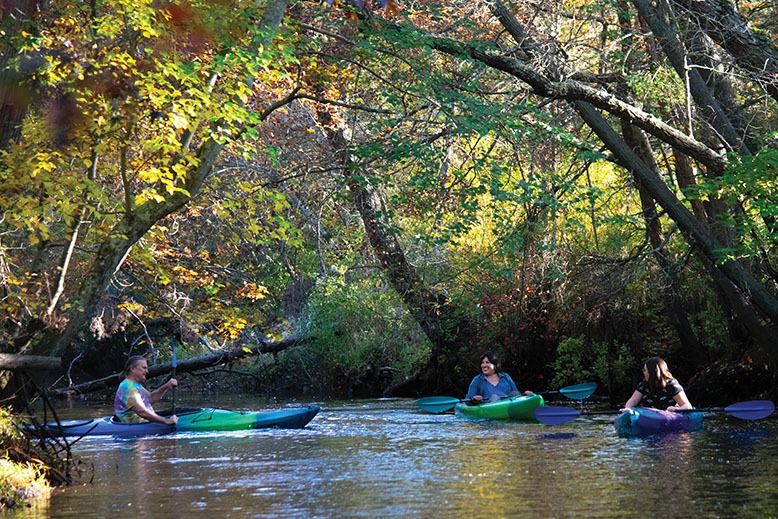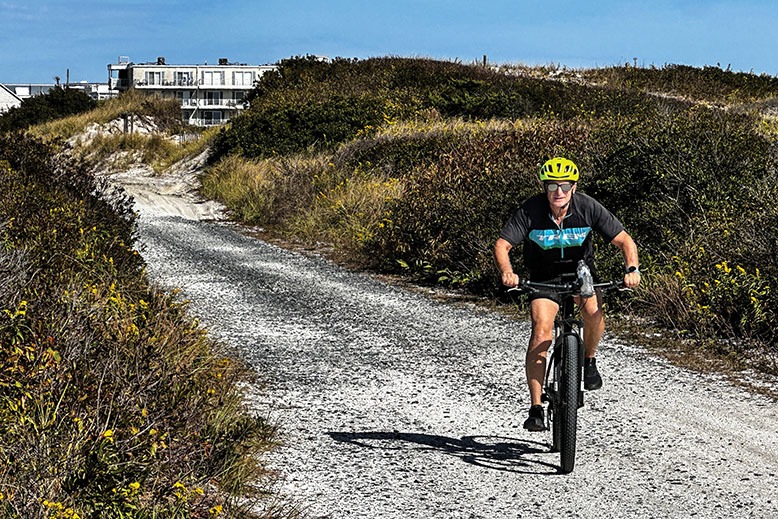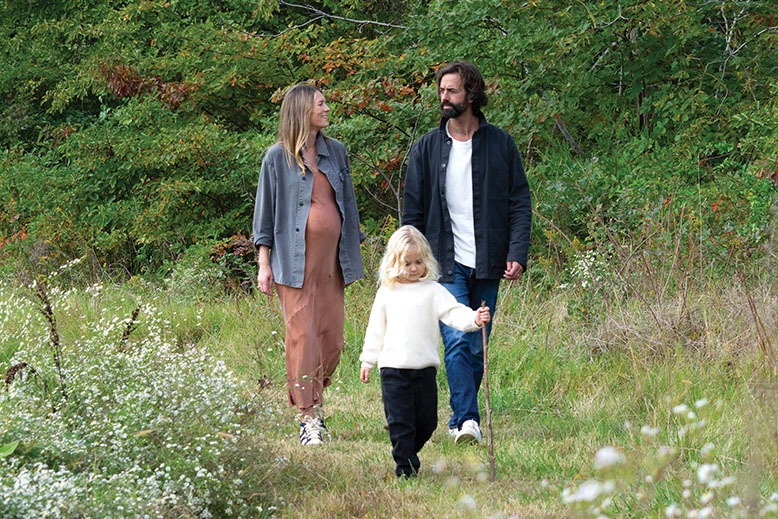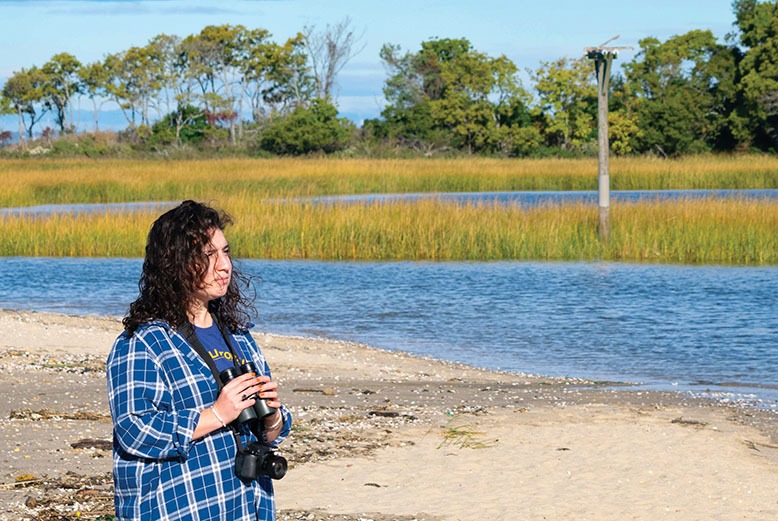Anyone who ventures to the ocean’s edge in April and feels the wind blasting across 40-degree water is likely tempted to flee until Memorial Day. But take a lesson from those who live and work close to nature at the Shore: Spring is the time to experience a marine world where ospreys are returning from their winter homes, seals are playing on the rocks before heading north, and buds on the beach-plum bushes are waiting for the last freeze before blossoming.
“I am evangelical that you should go outside year-round because there’s something to see every day of the year,” says self-described bird nerd Lindsay McNamara, assistant director of the American Littoral Society. “Seeing the seasonality of a place is really beautiful; if you only visit two or three days of the year, you don’t get the spirit of the place.” Here is how locals are embodying that philosophy.
Spiritual connection

Ivette Guillermo-McGahee and her family live on a home along the Mullica River. Photo: R.C. Staab
Within a long kayak ride of Barnegat Bay, Ivette Guillermo-McGahee and her family live in a home on five acres along the Mullica River, with Batsto Village and Wharton State Forest nearby in the Pinelands.
Living in a natural environment is essential to Guillermo-McGahee and goes beyond her physical well-being. “I work in mental health with people who have a lot of issues in their life,” she says. “Sometimes it’s hard to not bring things [home] with me.” Being in nature provides her with a much-needed “reminder that there is beauty close. It’s just a source of hope and confidence. We have internal resources to regenerate, to come back to life, to repair.”
[RELATED: The Best Outdoor Activities in New Jersey]
In 2012, Guillermo-McGahee founded Allies in Caring, a nonprofit providing mental health services to children and families in South Jersey. Initially, Guillermo-McGahee and her family lived in the town of Hammonton, but moved to their current location for a variety of reasons, including a vision that came to her in a dream. “I had a dream, and I thought, We need to have chickens and live in nature,” she says.
For almost a decade, they scouted for a rural home. “Nature connects me to the spirit of things, the spirit of life that, in a city, gets lost,” she says. “I have a spiritual way of doing things; that is, I make a decision and put it in my heart. I thought, This is not going to be only for us, but this is really a space where we can help create community.”
That includes leaving technology out of the equation. “You have to give up TV and social media and everything,” says Guillermo-McGahee. “It’s better to spend time outside with the plants.” And the chickens? They were around for many years, but last year, “they went into retirement” when they were no longer producing eggs.
Active lifestyle

Wayne Brodbeck loves to bike at Island Beach State Park. Photo: R.C. Staab
While some are focused on the spiritual nature of the outdoors, Wayne Brodbeck of Berkeley Township, near Seaside Park, is fixated on how much energy he burns when biking, kayaking or walking almost every day of the year.
Pointing to the monitors that measure his calories and glucose levels, Brodbeck talks about the life-changing moment in 2016 when he was diagnosed with Type 2 diabetes. After his diagnosis, Brodbeck retired from his job and moved from Jackson to the tiny section of Berkeley Township across the street from Island Beach State Park, less than a block from Barnegat Bay and a block from the beach.
“The target was how to have a super-high-quality retirement living in a beautiful place by the ocean,” he says.
As the largest state park at the Shore, Island Beach is a panacea for the sedentary, especially from Labor Day to Memorial Day.
“For biking,” he says, “I want to go into Island Beach State Park whenever I can, because it’s a nice, steady, I-don’t-have-to-think 17 miles where I can burn 600-700 calories.”
[RELATED: New Jersey’s Best Biking Trails: A Passionate Cyclist Shares His Secrets]
In the state park, he says, “Animals are more comfortable to come out without all the cars. Foxes, turtles, seagulls, ospreys, pelicans, dolphins, whales, raccoons. And lots of red foxes: I’ll probably see one cross right in front of me once a month when I’m biking at dusk.”
In the off-season, Brodbeck also loves riding the boards of the Seaside Heights boardwalk any time he wants—something he can never do in the summer.
“In the winter, you’re on your own. One thing I like about here: it’s six months of serenity,” he says.
Wheeling his kayak from his yard, it takes Brodbeck less than 10 minutes to reach the marina at Island Beach State Park. After launching into Barnegat Bay and heading south, he’s eager to burn another 500 calories weaving around coves and small islands dotted with Shore birds and raptors flying overhead.
Family legacy

Justine Gaver and her family found respite on a farm in her native Cape May. Photo: R.C. Staab
Justine Gaver grew up at the Shore on a 26-acre farm adjacent to the Cape May Canal, only a 10-minute bike ride away from the Victorian homes and resorts that have made Cape May one of America’s top seaside destinations.
“Going for walks outside is a big part of living here. Growing up, we walked in the woods every weekend. My dad called it our version of going to church,” Gaver says.
Leaving home to attend college in Philadelphia at the University of Pennsylvania, she eventually moved to New York, where she met and married professor of creative writing Daniel Magariel, whose recently published novel, Walk the Darkness Down, is partly set in the fictional town of Destiny, a clear nod to Cape May and the farm.
They started an educational services agency, which she runs, and had a son, Laurence. (They’ve since had another son, Sebastian.)
The Covid-19 pandemic changed their destiny in April 2020. They escaped the city for the family farm. “We were here for about two weeks when Danny looked at me and said, ‘Let’s expedite that long-term plan and finally build that house.’ It was always something we intended to do, but I figured it was something we would do 10 years from now,” Gaver says.
[RELATED: Jersey Shore Is Transforming Into a Hotspot for Year-Round Living]
Fortunately, since she left, she says, “the state really expanded, developed and curated the opportunities that it provides for residents to interact with nature in a meaningful way.” Cape May remains a place that is, as she tells first-time visitors, “a little island where one side is predominately farm fields and woods, and the other side is this Victorian town.”
Gaver says her husband used to tease her about being afraid of bugs, but now her older son can’t seem to get enough of them. “When he finds an insect exoskeleton, he wants to bring it home and put it in a jar on his bedside table,” Gaver says. “He loves fishing. He loves climbing trees. He’s digging in the dirt every chance he gets.”
Work and play

“If you only visit two or three days of the year, you don’t get the spirit of the place,” says Lindsay McNamara, who works in Sandy Hook. Photo: R.C. Staab
On the opposite end of the Shore, Lindsay McNamara, assistant director of the American Littoral Society, “works in a national park, but doesn’t work for the national park.” The park in question is the Sandy Hook unit of the Gateway National Recreation Area, which permits the American Littoral Society, an organization that promotes the study and conservation of marine life and habitat, to have offices there and offer guided birding walks, typically on a two-mile hike over flat terrain starting at Fort Hancock.
“We are walking from a field with raptors—invasive birds such as starlings and pigeons—past old stands with dead snags where the woodpeckers like to be,” she says. “Then we go through some bramble and brush area, and, as we get closer to marsh, we see the wading birds—the herons flying over. We can see in an hour and a half 40 different bird species in one walk because we are hitting so many different habitats.”
The change of the season from winter to spring is one of Sandy Hook’s must-visit periods, especially to see seals hanging out in the bay on rocks near Fort Hancock.
“They are very much sea puppies,” McNamara says. “They are very interactive when they don’t look like they are laying on a couch. They jump out of water like dolphins.”
At this time of year, northern gannets, which are offshore birds, are an example of what people don’t expect to see down the Shore. She says, “They are really striking, coming back to create a spectacle—a large number of birds or wildlife all together at the same time. You can watch them circle up by the thousands, and it becomes almost like a tornado of birds.”
Of course, nature has its dark side. “My mom is a Disney environmentalist. She likes to believe nothing eats anything. I say, ‘Hawks got to eat. So who are you rooting for? Somebody’s got to go!’”
McNamara is always birding and looking at nature. She enthusiastically tells everyone, “You just have to look up! If you look up, it’s there! I promise.”
“There are great parks in New Jersey—county, state, these little pocket parks, local spots,” she says. “They are what you make of them. And you don’t have to go to Yellowstone to see really cool things. And you don’t have to go in July.”
R.C. Staab is a travel writer, book author, and wildlife and Jersey Shore enthusiast.
No one knows New Jersey like we do. Sign up for one of our free newsletters here. Want a print magazine mailed to you? Purchase an issue from our online store.
